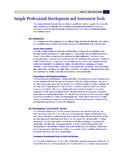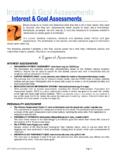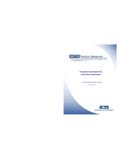Transcription of Differentiated Assessment Strategies: Identifying Learners ...
1 Quality Educational Programs, Inc. 1891 North Gaffey Street #228 San Pedro CA 90731 800-486-8650 Differentiated Assessment strategies : Identifying Learners Strengths and Needs A Distance Learning Graduate Course Course Syllabus 2009 Quality Educational Programs, Inc. Differentiated Assessment strategies Page 2. If I were teaching you how to play golf, I would not deter-mine whether you had met my standards by giving you a multiple-choice test. I would put you out on the golf course to "construct your own responses" in the face of real-world challenges. Similarly, in school we are ultimately less in-terested in how much information students can acquire than how well they can use it.
2 Jon Mueller Do we want to evaluate student problem-posing and prob-lem-solving in mathematics? experimental research in sci-ence? speaking, listening, and facilitating a discussion? do-ing document-based historical inquiry? thoroughly revising a piece of imaginative writing until it "works" for the reader? Then let our Assessment be built out of such exem-plary intellectual challenges. Grant Wiggins Differentiated Assessment strategies Page 3. Acknowledgements This course was made possible through the cooperation and contributions of Dr. Carol Ann Tomlinson Curry School of Education, University of Virginia and the quality administrators, teachers and students at these extraordinary schools: Procter Elementary School Independence, Missouri Callanan Middle School Des Moines, Iowa Parkview Middle School Ankeny, Iowa Norwalk High School Norwalk, Iowa Ronald Reagan Elementary School Wildomar, California Differentiated Assessment strategies Page 4.
3 Rationale While multiple-choice tests can be valid indicators or predictors of academic perform-ance, too often our tests mislead students and teachers about the kinds of work that should be mastered. Norms are not standards; items are not real problems; right answers are not rationales. Grant Wiggins Effective teachers strategically select an appropriate Assessment tool for each learning situation. In the same way that a carpenter chooses a hammer to drive a nail and a saw to cut a board, the teacher chooses the right tool for each purpose. Rich data is gathered us-ing a wide variety of instruments. This allows students to show what they know in more than one way.
4 In short, it takes more than one form of Assessment , or more than one tool , to gauge individual learning. What is Differentiated Assessment ? Differentiated Assessment is an ongoing process through which teachers gather data be-fore, during, and after instruction from multiple sources to identify Learners needs and strengths. Students are Differentiated in their knowledge and skills. They differ in the ways and speeds at which they process new learning and connect it to prior knowledge and understanding. They also differ in the ways they most effectively demonstrate their progress. Choosing the Right Tools The carpenter uses his expertise to choose the right tool for the procedure, the materials, and the task at hand.
5 The same principles apply to teachers and students on a far more sophisticated and consequential level. The teacher who plans instruction to accommodate the differences among students designs or selects the best preassessment tools. This re-veals students unique knowledge, prior experiences, abilities, learning styles, multiple intelligences, motivations, behaviors, interests, and attitudes. The results are used to stra-tegically customize instructional plans, provide students with multiple ways to show their learning, keep them on the right track, and accelerate their learning journeys. The Goals of This Course Our goals for this distance learning course include the following: - To give teachers Differentiated Assessment tools, strategies and activities to iden-tify a student s strengths and needs - To provide teachers with Assessment strategies they can give students to em-power them as self-directed Learners - To apply the latest research related to effective Assessment techniques Differentiated Assessment strategies Page 5.
6 - To present novel Assessment tools that provide immediate feedback for teachers and Learners - To provide teachers and Learners a variety of Assessment tools that are easy to remember and apply - To emphasize the value of creating a positive learning culture for Assessment experiences Building the Toolbox Differentiated instruction and Assessment go hand in hand. Marzano (2000) clarifies the goals of Assessment and instruction as follows: - Assessment should focus on students use of knowledge and complex reasoning rather than their recall of low-level information. - Instruction must reflect the best of what we know about how learning occurs To support this high level of instruction and Assessment , the teacher needs a constant stream of Assessment data.
7 This course presents Differentiated Assessment strategies and an overflowing box of tools to assess students before, during, and after learning. These tools are designed to help teachers identify students needs or holes in learning when they appear and expedite learning. The Benefits of Differentiated Assessment strategies Students and teachers benefit from Differentiated Assessment strategies because data gath-ered from various sources provide a metaphoric mosaic of each student s readiness for learning specific skills or subjects. The mosaic artwork is complete when each piece is in place to complete a design. Some mosaics are created from a multitude of small pieces, whereas others comprise large puzzle pieces.
8 In a similar way, various pieces of assess-ment data are needed to form a complete picture of the unique needs of a student. One standard may require detailed Assessment data to complete the whole picture. In an-other case, a quick observation of students may provide adequate Assessment data to use in planning because students need only one or two pieces of the puzzle. If the standard is composed of complete thinking processes, it may require multiple assessments to com-plete a total, in-depth view of the student. The teacher and student benefit when they work together to make all the pieces fit. (Adapted from Differentiated Assessment strategies by Carolyn Chapman and Rita King.)
9 Differentiated Assessment strategies Page 6. Course Title Differentiated Assessment strategies : Identifying Learners Strengths and Needs Course Description " Differentiated Assessment strategies : Identifying Learners Strengths and Needs is a three semester (five quarter) hour graduate course designed to give K-12 teachers the theory and skills to align Assessment practices to meet the diverse needs of Learners in today s classrooms. Participants will engage in various learning activities through which they will learn and implement formal and informal Assessment strategies before, during, and after learning. In addition, participants will show evidence of their understanding of differentiat-ing Assessment using sound Differentiated instructional practices with a Differentiated as-sessment framework.
10 Participants will demonstrate proficiency in utilizing Differentiated Assessment tools by designing, implementing, and evaluating lessons and units based on the knowledge and skills learned in this course. Course Goals The goals of this course are to have participants develop an understanding of dif-ferentiated Assessment strategies . By the end of this course participants will be able to: utilize Differentiated Assessment tools, strategies and activities to identify a student s strengths and needs; apply the latest research related to effective Assessment techniques; effectively utilize a variety of Assessment tools that are easy to remember and apply; and create a positive learning culture for Assessment experiences.







